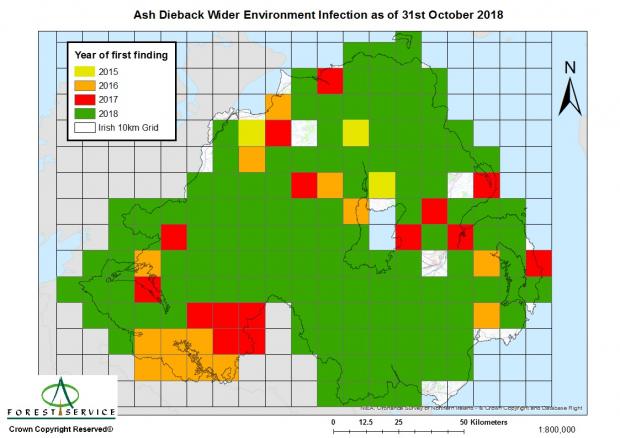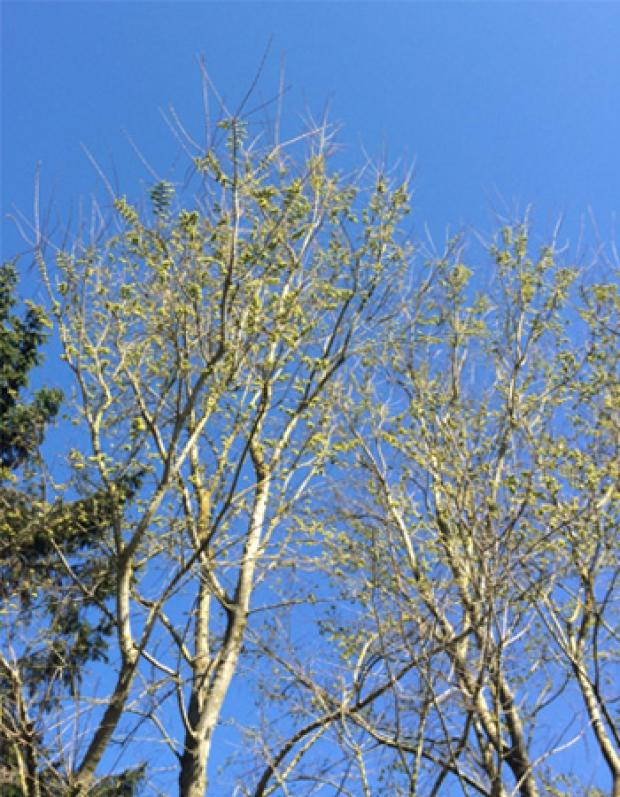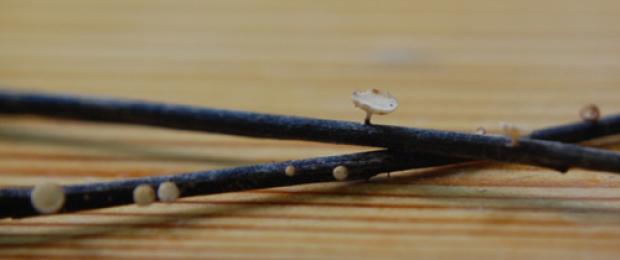Description
Chalara dieback of ash, also known as Chalara or ash dieback, is a disease of ash trees caused by a fungus called Hymenoscyphus fraxineus. (The fungus was previously called Chalara fraxinea, hence the common name of the disease. See 'The Science' below for an explanation of the name change.)
Threat
We don't yet know what the full impact of Chalara will be in Northern Ireland. Evidence from continental Europe suggests that older, mature ash trees can survive infection and continue to provide their landscape and wildlife benefits for some time.
The best hope for the long-term future of Northern Ireland's ash trees lies in identifying the genetic factors which enable some ash trees to tolerate or resist infection, and using these to breed new generations of tolerant ash trees for the future. Northern Irish scientists (including AFBI) and regulators (e.g. DAERA) are working closely with our British and Irish counterparts to screen indigenous ash trees for tolerance to the pathogen with a view to breeding tolerant to re-vegetate the wider countryside in the future.
Northern Ireland Risk register rating
| Organism | Hosts | NI Risk Rating |
|---|---|---|
| Hymenoscyphus fraxineas | Fraxinus | 110 |
Susceptible species
Chalara dieback of ash is especially destructive of common or European ash (Fraxinus excelsior), including its ‘Pendula’ ornamental variety. Narrow-leaved ash (Fraxinus angustifolia) is also susceptible, and both species have been affected in the UK.
Spread
Local spread, up to some tens of miles, may be by wind. Over longer distances the risk of disease spread is most likely to be through the movement of diseased ash plants. Movement of logs or unsawn wood from infected trees might also be a pathway for the disease, although this is considered to be a low risk.
Outbreak stage and national plans
Ash trees suffering with Chalara infection have been found widely across Europe since trees were first reported dying in large numbers in Poland in 1992. It was first confirmed in the UK in February 2012 when it was found in a consignment of infected trees sent from a nursery in the Netherlands to a nursery in Buckinghamshire, England. The first signs of Ash dieback in Northern Ireland were found in young forest plantations in Co. Antrim in Autumn 2012. The trees were most likely infected at the source nursery where they were grown. Improved monitoring techniques continue to uncover new finds (see Distribution section below). [UPDATE on wider environment findings]
Hymenoscyphus fraxineus, the fungal agent which causes Chalara dieback of ash, is treated as a quarantine organism under national emergency measures, and any suspected sighting must be reported.
Distribution
Ash Die-back is considered to be present in the wider environment, with increasing likelihood of ash trees, including recently planted ash, becoming infected in situ. Eradication of the disease has been deemed not to be a feasible option. Since 2017, Ash Die-back surveys have not routinely included inspection of recently planted ash sites but have concentrated on determining the presence of the disease in established ash.
In 2018 the survey objective is again to provide information on the progress of Ash Die-back in the wider environment in Northern Ireland. The presence of the disease will be mapped at a 10km resolution.
The map below shows 10km Irish Grid squares in which at least one confirmation of ash dieback infection in native ash trees has been made.

The progression of numbers and appearance of new grid squares over time should not be interpreted as an indication of the rate of spread of the disease. It only indicates when infection sites were found, not when the fungus first arrived on the site, which in many cases cannot be known.
Current situation in the UK
The forestry commission have completed a survey of Ash dieback confirmed findings across the UK as a whole. As of September 2018, 49.2% of the UK landmass, split by 10km grid squares, was found to have been infected. A map can be found here.
Symptoms
Ash dieback is characterised by three symptoms:
- Dead tops and/ or side shoots at the base of dead side shoots, lesions can often be found on the subtending branch or stem
- Lesions which girdle the branch or stem can cause wilting of the foliage above
- Mature trees affected by the disease initially display dieback of the shoots and twigs at the periphery of their crowns. Dense clumps of foliage may be seen further back on branches where recovery shoots are produced in the crown of the tree. The new shoots are killed by the pathogen and appear as leafless branches protruding from the canopy.


Management, grants, treatment
You are not required to take any particular action if you own infected ash trees, unless we or another plant health authority serves you with a statutory Plant Health Notice requiring action. Keep an eye on the trees' safety as the disease progresses, and prune or fell them if they or their branches threaten to cause injury or damage.
In low-density situations such as parks and gardens, you can help to slow the spread of the disease by removing and disposing of infected ash plants, and collecting up and burning (where permitted), burying or composting the fallen leaves. This breaks the fungus's life cycle.
The science
Chalara dieback is caused by a fungus called Hymenoscyphus fraxineus. This fungus has two phases to its life-cycle: sexual and asexual. The asexual stage, which grows in affected trees, attacking the bark and girdling twigs and branches, was the first to be described by science, and called Chalara fraxinea. This gave rise to the common name of the disease which it causes.
The sexual, reproductive stage, which was only discovered later, occurs on infected rachises, or stalks, of the previous year's fallen leaves. The sexual stage involves the production of minute white cup-shaped fruiting bodies of the fungus known as Hymenoscyphus fraxineus. As Chalara fraxinea and Hymenoscyphus fraxineas are just different stages of the same organism, the proper name for the organism is now accepted to be Hymenoscyphus fraxineas. However, the common name for the disease “Chalara”, still persists in general usage.
Government scientists have set out the most up-to-date understanding of the disease. Their assessment concluded that:
- the spores are unlikely to survive for more than a few days;
- spore dispersal on the wind is possible from mainland Europe;
- trees need a high dose of spores to become infected;
- spores are produced from fruiting bodies on infected dead leaves during June to September;
- there is a low probability of dispersal on clothing or animals and birds;
- the disease will attack any species of ash;
- the disease becomes obvious within months rather than years;
- wood products would not spread the disease if treated properly;
- once infected, trees can’t be cured; and
- not all trees die of the infection - some are likely to have genetic factors which give them tolerance of, or resistance to, the disease.
Scientists are working to learn from existing and emerging research and practical experience in combating the disease in other countries. AFBI scientists are involved in monitoring the spread of the disease using novel technologies. Furthermore, both DAERA and AFBI are involved in international projects screening ash trees from the island of Ireland for tolerance to the pathogen.
Control of the spread of the disease is also possible in some situations. Data on the fungicides suitable for control of the disease in plants is available here, and biocides suitable for controlling the spread of the disease on footwear and tyres can be found here.
Origins
The fungus is believed to have entered Northern Ireland on plants imported from nurseries. However, now that we have found infected older trees in Northern Ireland with no apparent connection with plants supplied by nurseries, we are also investigating the possibility that it might have entered by natural means (including spread in the air).
According to the European and Mediterranean Plant Protection Organization (EPPO), Austria, Belgium, the Czech Republic, Finland, France, Germany, Hungary, Italy, Lithuania, the Netherlands, Norway, Poland, Slovenia and Sweden have confirmed its presence. On the basis of symptoms, the disease has also been observed in Denmark, Estonia, Latvia and Switzerland.
Pest risk analysis
A Pest Risk Analysis (PRA) for Ireland and the UK was published in May 2013. (The document title uses the former name of the sexual stage of the fungus, Hymenoscyphus pseudoalbidus.)
Import & movement restrictions
Legislation is now in force to prevent the introduction and spread of Ash Dieback here through plants, seeds and wood.
- Ash Plants and Seeds for Planting [LINK]
- The Plant Health (Amendment No.3) Order (Northern Ireland) 2012 (legislation.gov.uk website)
- Ash Wood and Bark [LINK]
Further information
- Ash dieback flyer
- All Ireland Chalara control strategy
- Risk of moving untreated wood
- Department of Agriculture, Environment and Rural Affairs, Northern Ireland Chalara webpage
- Forestry Comission Chalara webpage
- Department of Agriculture, Food and the Marine Ireland Chalara webpage
Questions and answers
Contact:
Plant Health Inspection Branch
DAERA Northern Ireland
Tel: 0300 200 7847
Email: planthealth@daera-ni.gov.uk
